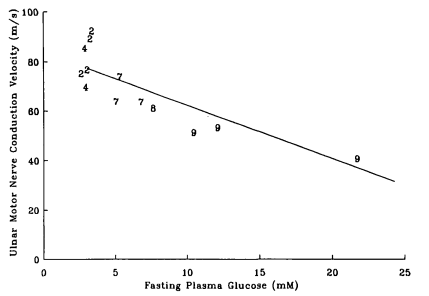Abstract
Peripheral neuropathy is a significant complication of human diabetes and a source of morbidity. Appropriate experimental models may aid in understanding its pathogenesis and in developing therapeutic strategies. We sought to determine whether spontaneously diabetic obese adult monkeys developed peripheral neuropathy and whether it occurred early or late in relation to the onset of hyperglycemia. We studied nerve conduction in both motor (peroneal, median, and ulnar) and sensory (median and ulnar) nerves in 13 adult male rhesus monkeys, 4 overtly diabetic and 9 nondiabetic (mean age 21 ± 2 and 16 ± 2 yr, respectively, NS; mean fasting plasma glucose 14.5 ± 3.4 and 4.4 ± 0.6 mM, P = .001). The diabetic animals had significantly reduced motor conduction velocities and prolonged F-wave latencies. Motor-evoked amplitudes did not differ. In the diabetic monkeys, nerve conduction times were increased in motor fibers, which could be identified as early as 2 yr after the onset of hyperglycemia. These abnormalities are similar to those seen in humans and suggest further study of these animals as a primate model of human diabetic neuropathy.

Fig. 3. Ulnar motor nerve conduction velocity plotted against fasting plasma glucose for 13 rhesus monkeys. Value for each animal is represented by number (2-9) that is metabolic phase of progression from normal to diabetic (5). Regression line is significant at P = .0002
Tel : 028-8592-1823 (in China)
Tel:+1-517-388-6508 (in US)
Tel : +86 (28) 8592-1823 (outside of China)
Fax : +86-28-62491302
Zip code : 610041
Address: No.88, Keyuan South Road, Hi-tech Zone, Chengdu, Sichuan Province, China